


or the algae Ulva fasciata or Enteromorpha sp., which prevent spat recruitment. On the other hand, the oyster collectors were those that attracted the highest quantity of fouling organisms, such as barnacles Balanus sp. The collector made of PET bottle material always had the lowest number of spat (usually with less than 10 spat per collector) ( Fig. O número de sementes de ostras foi positivamente correlacionado com a salinidade ( ρ s= 0,331 P tire > PET). The number of oyster spat was positively correlated with the salinity ( ρ s= 0.331 p 0,05). Spat settlement was significantly higher on oyster shell, tile and tire collectors, mainly at points with higher salinities, such as Praia do Coqueiro in Anchieta and on Meio and Cabrito Islands in Piúma (Kruskal-Wallis: H= 10.01 3 d.f. The number of spat recruited on each collector and their shell lengths were registered bimonthly, as well as the physico-chemical-trophic parameters of the water: salinity, temperature, dissolved oxygen, particulate organic matter and chlorophyll a, which were correlated (by Spearman's correlation) with the number of spat recruited. The collectors were made of: 1- oyster shells, 2- PET bottles, 3- car tires and 4- tiles, all of them suspended by ropes and tied to roots of Rhizophora mangle or mussel long-lines. at five sites in the Benevente river estuary, Anchieta District and on two islands in Piúma District, both in Espírito Santo State. This paper evaluated the effectiveness of four types of oyster spat collectors, made with recycled materials, in the recruitment of the mangrove oyster Crassostrea spp. Universidade Federal do Espírito Santo Departamento de Ecologia e Recursos Naturais CCHN Laboratório de Bentologia (Av. Oyster spat recruitment in Espírito Santo State, Brazil, using recycled materials


 0 kommentar(er)
0 kommentar(er)
